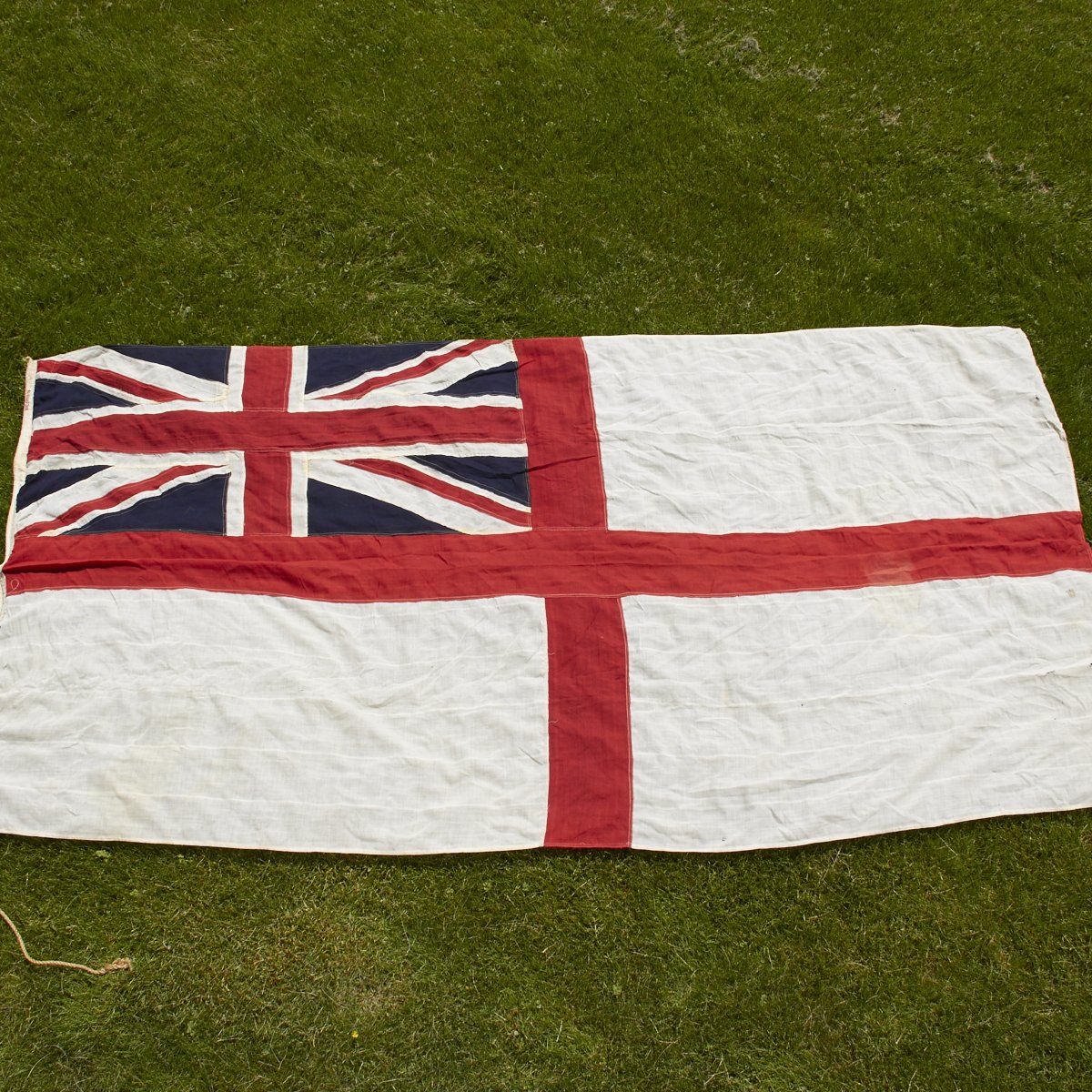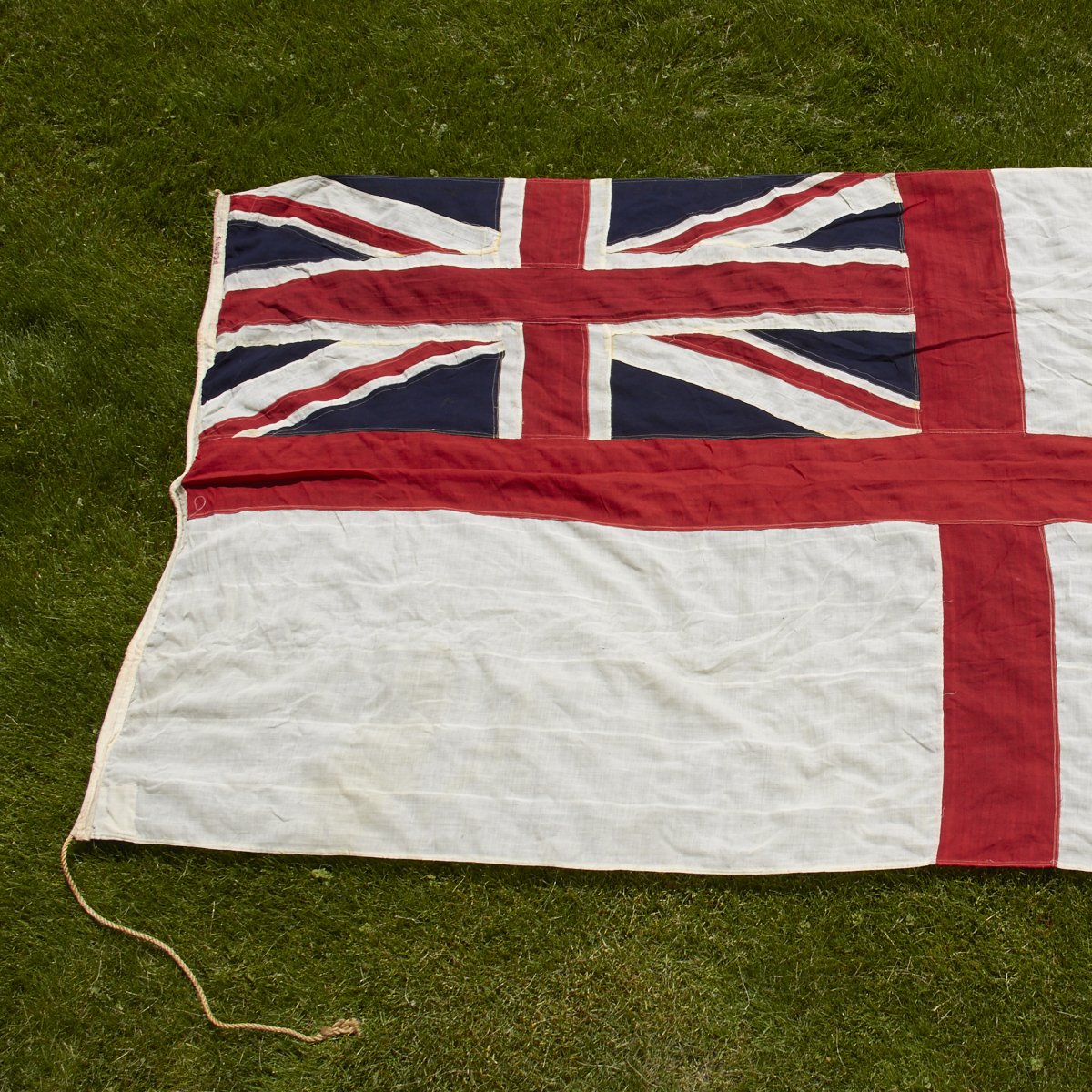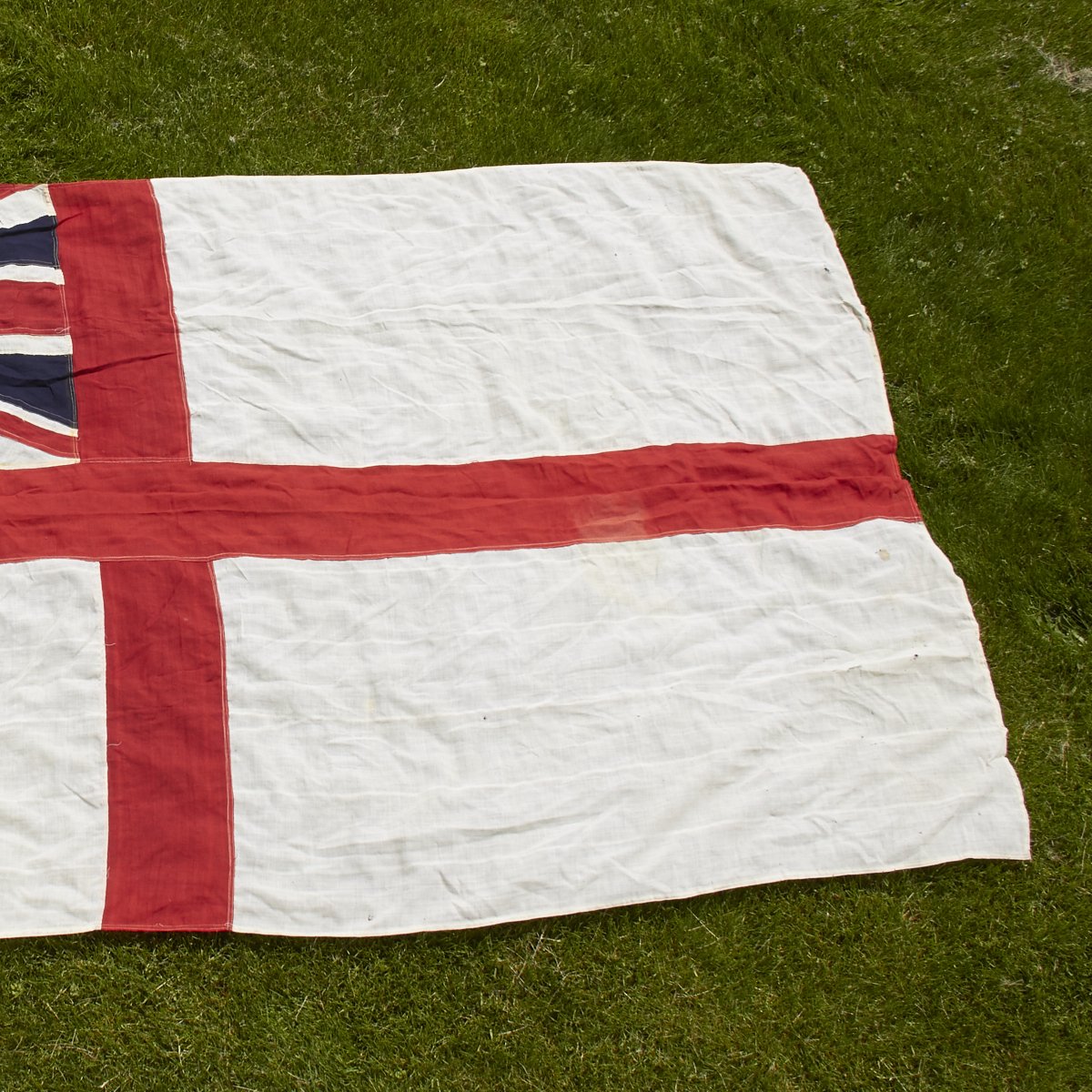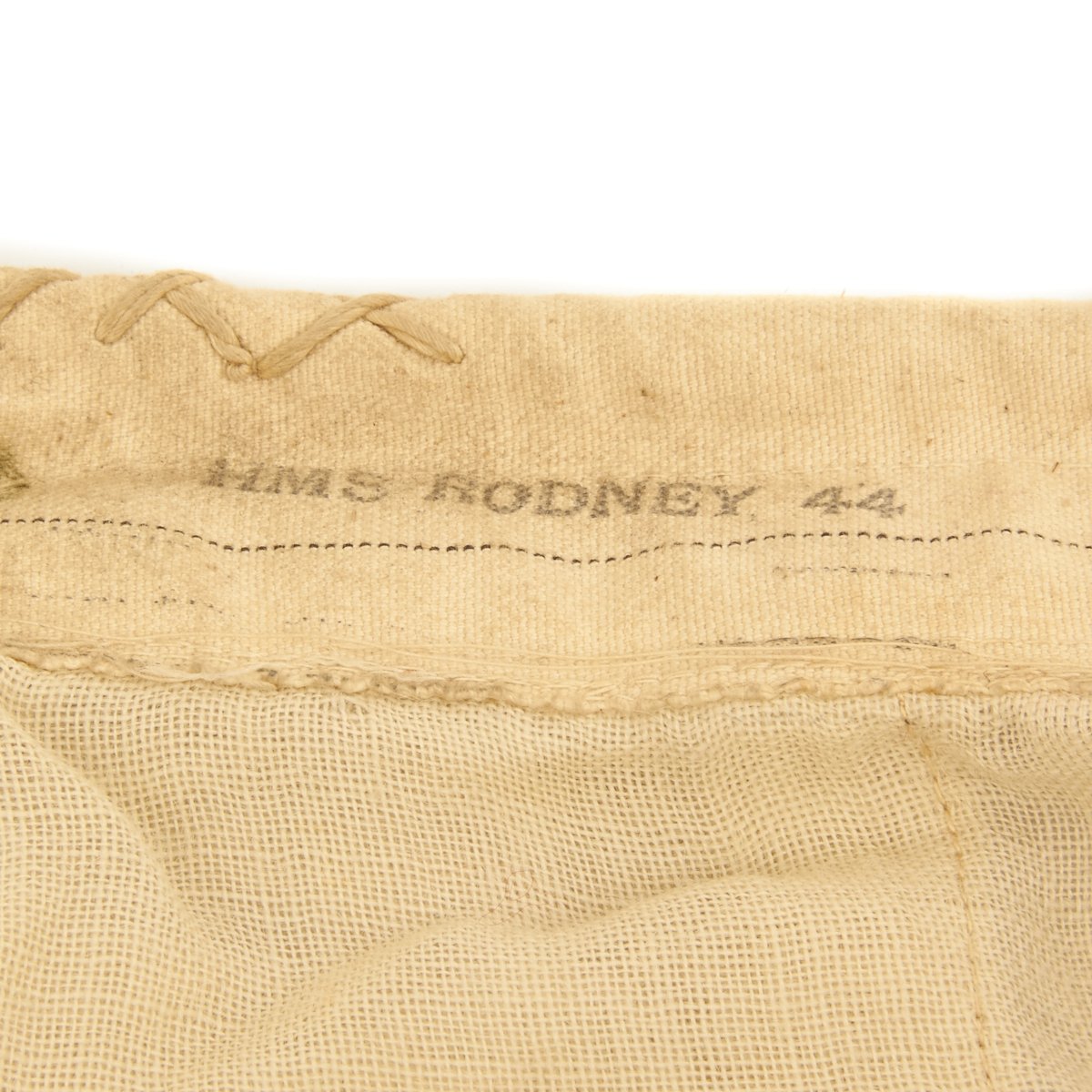Original British WWII D-Day Landing White Ensign Battle Flag of the HMS Rodney Dated 1944 Original Items
$ 1.495,00 $ 373,75
Original Item: One-of-a-kind. This is remarkable, it is the main Battle Flag of the HMS Rodney, the Nelson Class Battleship of 33,000 plus tons that took part in the D-Day Landings on June the 6th, 1944.
HMS Rodney (pennant number 29) was one of two Nelson-class battleships built for the Royal Navy in the mid-1920s. The ship was named after Admiral Lord Rodney. The Nelsons were unique in British battleship construction, being the only ships to carry a main armament of 16-inch (406 mm) guns, and the only ones to carry all the main armament forward of the superstructure. As her superstructure was located aft of midships like RN fleet oilers whose names carried the …’ol’ suffix, she was sometimes derisively referred to as “Rodnol”. Commissioned in 1927, Rodney served extensively in the Mediterranean Sea and Atlantic Ocean during World War II.
Rodney played a major role in the sinking of the German battleship Bismarck in May 1941. During and after Operation Torch and the Normandy landings, Rodney participated in several coastal bombardments. In poor condition from extremely heavy use and lack of refits, she was scrapped in 1948.
The flag, known as the White Ensign, was the main battle flag of the ship measuring 124″ x 70″, about 10 feet by 6 feet. It is ink stamped HMS RODNEY 44 and BOATSWAINE 8 on the canvas boarder. It is in remarkable condition but shows some use and has a minimal amount of moth and other very minor wear.
Saved by a member of the crew this battle flag has a colorful and unique history.
From commissioning until World War II broke out in September 1939, Rodney spent the entire time with the British Atlantic Fleet or Home Fleet. In 1931, her crew joined the crews of other ships taking part in the Invergordon Mutiny. In October 1938 a prototype type 79Y radar system was installed on Rodney’s masthead. She was the first battleship in the Royal Navy to be so equipped.[1] In 1940 the type 79Y radar was replaced with type 279 and UP AA rocket projectors were fitted to ‘B’ and ‘C’ turrets, but removed in 1941 after concern about their safety and effectiveness. These were replaced by 35 single 20 mm Oerlikons over the next three years.
Following the sinking of armed merchant cruiser HMS Rawalpindi on 23 November 1939 by the German battleships Scharnhorst and Gneisenau, Rodney hunted the enemy ships but developed serious rudder defects and was forced to return to Liverpool for steering gear repairs until 31 December. Rodney was damaged by German aircraft at Karmoy, near Stavanger on 9 April 1940, when hit by a 500 kg (1,102 lb) bomb that pierced the upper deck aft of the funnel, but did not explode and exited sideways after striking the armoured deck.[2] On 13 September, she was transferred from Scapa Flow to Rosyth with orders to operate in the English Channel when the German invasion of Britain was expected. In November and December, Rodney was assigned convoy escort duties between Britain and Halifax, Nova Scotia. In January 1941, Rodney joined the hunt for the German battleships Scharnhorst and Gneisenau, without success. On 16 March, however, while escorting a convoy in the North Atlantic, contact was made with the German battleships, but no battle followed, as the German ships turned away when they realised that they were facing superior firepower.
In May 1941, while commanded by Captain Frederick Dalrymple-Hamilton, Rodney was ordered to sail to Canada, along with the ocean liner MV Britannic and four destroyers. Rodney was intended to travel on to the United States for repairs and refits; the ship carried a number of passengers, as well as additional materials, such as boiler tubes and anti-aircraft guns intended for use in her refit. Britannic was taking civilians to Canada and would be bringing Canadian troops and airmen back to Britain.
It was during this run on 24 May that she was called on by the Admiralty to join in the pursuit of the German battleship Bismarck, leaving the destroyer Eskimo to escort Britannic and taking Somali, Mashona and Tartar with her in the search. Despite Admiral Sir John Tovey in the battleship King George V heading north-west due to a misinterpreted signal from the Admiralty, Dalrymple-Hamilton and his own ‘Operations Committee’ consisting of Captain Coppinger (newly appointed captain of the battleship Malaya, which was undergoing repairs in New York); Navigator, Lt. Cmdr. Galfrey George Gatacre RAN; USN Naval Attaché, Lt. Cmdr. Joseph Wellings and Executive Officer, Cmdr. John Grindle, decided that Bismarck was probably heading for Brest and so set course to the east to head Bismarck off, ‘at some stages exceeding her designed speed by two knots’, despite her engines being in need of an overhaul.
On 26 May, she joined up with King George V, as Admiral Tovey had realised his mistake and doubled back. Tovey then sent the three remaining destroyers home because they were low on fuel, and had Rodney fall in behind King George V for the battle against Bismarck the next day. Early on the morning of 27 May 1941, along with the battleship King George V and the cruisers Norfolk and Dorsetshire, she engaged Bismarck, which had damaged rudder machinery, due to a torpedo launched by the aircraft carrier Ark Royal’s Fairey Swordfish bombers the day before. Unable to manoeuvre and listing to port, Bismarck scored no hits before her forward guns were knocked out, after which Rodney closed with Bismarck until she was firing on a virtually flat trajectory and spotters could actually follow the shells to the target. One 16-inch shell was tracked from the gun to where it hit the face of Bismarck’s #2 turret Bruno and exploded, blowing out the back of the turret, with the resulting splinters killing most of the crew on the bridge. Rodney fired 340 16-inch shells, some in 9-gun broadsides and 716 6-inch shells during the battle, scoring many hits from a range of under 3,000 yards (2,700 m) and inflicting most of the damage suffered by Bismarck, whose stern was blown off.
During the battle, Rodney also fired twelve 24.5-inch (622 mm) torpedoes at Bismarck whilst zig-zagging across her bow; most of the torpedoes missed but one hit Bismarck and exploded amidships on the starboard side, making Rodney the only battleship in history to have torpedoed another battleship, although Bismarck survived the hit by Rodney’s torpedo. Rodney and King George V finally broke off the action; Dorsetshire was then ordered to finish Bismarck off with torpedoes. Rodney and King George V, running short on fuel, were ordered home and were attacked by Luftwaffe bombers, who sank Mashona but missed Tartar, with whom the battleships had rejoined.
After refuelling at Gourock, Rodney sailed to the South Boston Navy Yard in Boston, Massachusetts, for the delayed repairs to her engines and the installation of more 8-barrelled “Pom-Pom” AA guns, which had been carried in crates on the deck throughout the battle. This is significant because the United States did not formally enter the war for several months and the docking of Rodney illustrated the US government’s true sympathies in the growing global conflict. Since the repairs took several weeks to complete, Rodney’s crew was furloughed to local Civilian Conservation Corps camps. In the interim, some members of the crew struck up lasting relationships with American civilians.
In September 1941, Rodney was stationed with Force H in Gibraltar, escorting convoys to Malta. In November, she returned home and was stationed in Iceland for a month and then underwent refit and repair until May 1942. After the refit, she returned to Force H, where she again escorted Malta convoys and took part in Operation Torch, the invasion of Northwest Africa. She was subsequently involved with the Invasion of Sicily and Salerno. From October 1943, she was in the Home Fleet, and took part in the Normandy invasion in June 1944, where she was controlled from the headquarters ship HMS Largs off Sword Beach. Her tasks included a 30-hour operation firing an occasional shell 22 miles (35 km) inland, to prevent a Panzer division from crossing a bridge. She also destroyed targets at Caen and Alderney. On 7 June 1944 a collision between Rodney and LCT 427 resulted in the loss of 13 Royal Navy seamen. In September 1944, she performed escort duties with a Murmansk convoy.
Fast Shipping with Professional Packaging
Thanks to our longstanding association with UPS FedEx DHL, and other major international carriers, we are able to provide a range of shipping options. Our warehouse staff is expertly trained and will wrap your products according to our exact and precise specifications. Prior to shipping, your goods will be thoroughly examined and securely secured. We ship to thousands clients each day across multiple countries. This shows how we're dedicated to be the largest retailer on the internet. Warehouses and distribution centres can be located throughout Europe as well as the USA.
Note: Orders with more than one item will be assigned a processing date depending on the item.
Before shipping before shipping, we'll conduct a thorough inspection of the items you have ordered. Today, the majority of orders will be delivered within 48 hours. The delivery time will be between 3-7 days.
Returns
The stock is dynamic and we cannot completely manage it because multiple stakeholders are involved, including our factory and warehouse. So the actual stock may alter at any time. It's possible that you may not receive your order once the order has been made.
Our policy is valid for a period of 30 days. If you don't receive the product within 30 days, we are not able to issue a refund or an exchange.
You can only return an item if it is unused and in the same state as the day you received it. You must have the item in its original packaging.
Related products
Uncategorized
Uncategorized
Angolan Rebel 1970s era 60mm Inert Display Mortar from Angolan Civil War Original Items
Uncategorized
Uncategorized
Uncategorized
Uncategorized
Uncategorized
Uncategorized
Uncategorized
Uncategorized
Uncategorized
Uncategorized
Uncategorized
Armored Burgonet Helmet & Polearm from Scottish Castle Leith Hall Circa 1700 Original Items
Uncategorized
Uncategorized
Uncategorized
Australian WWII Owen MK1 Machine Carbine SMG Custom Fabricated Replica with Sling Original Items
Uncategorized
Armoured Fighting Vehicles of the World: AFVs of World War One (Hardcover Book) New Made Items
Uncategorized
Uncategorized










































































